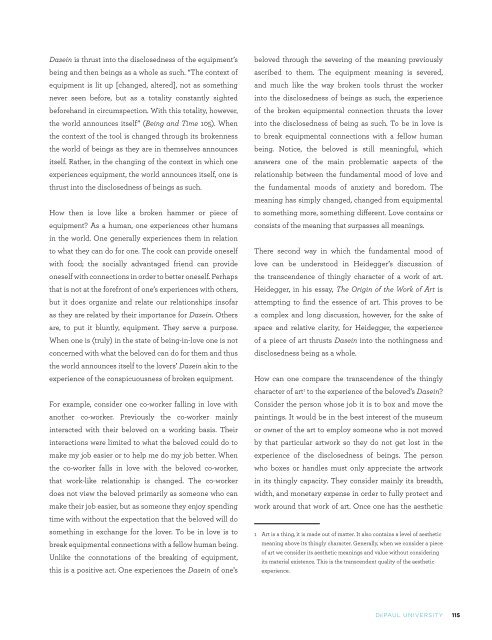UNDERGRADUATE
Ycb5305N2JX
Ycb5305N2JX
Create successful ePaper yourself
Turn your PDF publications into a flip-book with our unique Google optimized e-Paper software.
experience of the transcendence of its thingly character<br />
one is no longer capable (or as least easily so) of working<br />
around that painting. 2 This example in Heidegger is<br />
comparable with the rule that doctors are not allowed to<br />
treat their loved ones. A doctor, to an extent, must reduce<br />
the person they are treating down to solely a thingly being.<br />
They are treating flesh and bone, not the patient’s Dasein.<br />
A doctor cannot treat their loved ones because they are<br />
not capable of experiencing solely the thingly character of<br />
their beloved’s Dasein. They cannot work around it, much<br />
like the person who boxes the paintings cannot work<br />
around the painting that moves them. There then must<br />
be something in the experience of the Dasein of one’s<br />
beloved that thrusts one into the disclosedness of beings<br />
as such insofar as one cannot work around the Dasein<br />
of one’s beloved. This is how one can understand love<br />
insofar as it is a fundamental mood through Heidegger’s<br />
discussion of the aesthetic experience of an artwork that<br />
moves oneself.<br />
Let’s recall Heidegger’s exact language “Another<br />
possibility of such revelation is concealed in our joy in the<br />
presence of the Dasein—and not simply of the person—of<br />
a human being whom we love” (Basic Writings 99). In the<br />
presence of the Dasein of the person whom we love, the<br />
beloved is no longer simply a thing, but rather something<br />
more much like in the experience of the transcendence of<br />
the thingly character of a piece of art that moves us. The<br />
transformation of the beloved’s Dasein occurs in the act<br />
of falling in love, when the equipment-like character of<br />
the fellow human falls away, when the meaning normally<br />
attached to fellow humans is traded for something more<br />
than equipment. In love, the beloved’s Dasein accrues<br />
a new meaning, the equipment like quality of Others<br />
falls away, changed to something fundamental. In love,<br />
the beloved’s thing-ly body can be transcended, and yet<br />
the Dasein remains irreducibly present. The beloved is<br />
fundamental.<br />
To conclude, in this analysis I examined three of<br />
Heidegger’s works: What is Metaphysics, Being and Time,<br />
and The Origin of the Work of Art. I argued that we cannot<br />
conceptualize the fundamental mood of love in concert<br />
with the fundamental moods of anxiety or boredom but<br />
we can conceptualize and fit in the fundamental mood<br />
of love, or the experience of the beloved’s Dasein, with<br />
Heidegger’s discussion of both the conspicuousness of<br />
broken equipment and the transcendence of the thing-ly<br />
character of a work of art.<br />
2 On a personal note, as someone employed as an art handler, this is<br />
absolutely true. One time, after two straight days of examining and<br />
cleaning framed works of art, someone asked me which one of the pieces<br />
I was working with was my favorite. I had to take a step back and actually<br />
examine them as art, I had only been considering their thingly nature.<br />
WORKS CITED<br />
Heidegger, Martin. Basic Writings: From Being and Time and The Task<br />
of Thinking. Ed. David Farrell. Krell. New York: Harper Perennial Modern<br />
Thought, 2008. Print.<br />
Heidegger, Martin. Being and Time. Trans. John Macquarrie. Ed. Edward S.<br />
Robinson. New<br />
York: HarperPerennial/Modern Thought, 2008. Print.<br />
116 CREATING KNOWLEDGE


